Mirogabalin for the treatment of diabetic peripheral neuropathic pain: A randomized, double-blind, placebo-controlled phase III study in Asian patients
- PMID: 30672128
- PMCID: PMC6717827
- DOI: 10.1111/jdi.13013
Mirogabalin for the treatment of diabetic peripheral neuropathic pain: A randomized, double-blind, placebo-controlled phase III study in Asian patients
Abstract
Aims/introduction: This study evaluated the efficacy and safety of mirogabalin, a novel, potent, selective ligand of the α2 δ subunit of voltage-dependent Ca2+ channels, for the treatment of diabetic peripheral neuropathic pain (DPNP).
Materials and methods: During this double-blind, multisite, placebo-controlled phase III study, Asian patients aged ≥20 years with type 1 or 2 diabetes and DPNP were randomized 2:1:1:1 to a placebo, mirogabalin 15, 20 or 30 mg/day for up to 14 weeks, with a 1- to 2-week titration (NCT02318706). The primary endpoint was the change from baseline in average daily pain score (ADPS) at week 14, defined as a weekly average of daily pain (0 = no pain to 10 = worst possible pain, for the past 24 h).
Results: Of 834 randomized patients, 330, 164, 165 and 165 received placebo, mirogabalin 15, 20 or 30 mg/day, respectively, and were included in analyses (modified intention-to-treat population, n = 824); 755 (90.5%) completed the study. At week 14, the least squares mean average daily pain score change from baseline was -1.31, -1.34, -1.47 and -1.81, respectively, showing statistical significance for mirogabalin 30 mg/day versus placebo (P = 0.0027). The treatment-emergent adverse events observed were mostly mild-to-moderate in all mirogabalin doses, and the most frequent treatment-emergent adverse events were nasopharyngitis, somnolence, dizziness, peripheral edema and weight increase.
Conclusions: Mirogabalin relieved DPNP in a dose-dependent manner; mirogabalin 30 mg/day showed statistically significant pain relief (vs placebo) in Asian DPNP patients. All doses of mirogabalin tested were well tolerated.
Keywords: Diabetic peripheral neuropathic pain; Mirogabalin; Pain.
© 2019 The Authors. Journal of Diabetes Investigation published by Asian Association for the Study of Diabetes (AASD) and John Wiley & Sons Australia, Ltd.
Figures


References
-
- daCosta DiBonaventura M, Cappelleri JC, Joshi AV. A longitudinal assessment of painful diabetic peripheral neuropathy on health status, productivity, and health care utilization and cost. Pain Med 2011; 12: 118–126. - PubMed
-
- Sadosky A, Mardekian J, Parsons B, et al Healthcare utilization and costs in diabetes relative to the clinical spectrum of painful diabetic peripheral neuropathy. J Diabetes Complications 2015; 29: 212–217. - PubMed
Publication types
MeSH terms
Substances
Grants and funding
LinkOut - more resources
Full Text Sources
Medical
Miscellaneous

